-
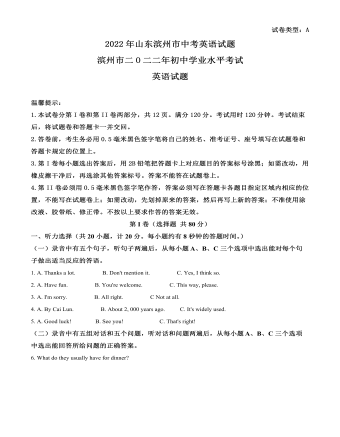
2022年山东省滨州市中考英语真题(解析版)
Everyone knows how similar chimpanzees (黑猩猩)are to humans. So it’s no surprise that their greetings are also close to ours.The most common ways of greeting between chimpanzees are hand touching andhugging. Sometimes they also kiss each other. Some chimpanzees can even learnsimple sign language.
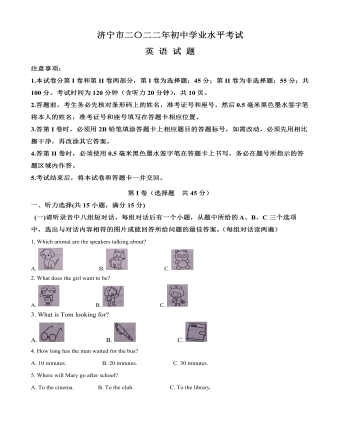
2022年山东省济宁市中考英语真题(解析版)
Raden Roro Hendarti, nearly 50 years old, is alibrarian in Muntang village. She started a “trash library”, hoping to makechildren read more as well as make them realize the importance of environmentprotection. Each weekday, Raden puts all kinds of books on the back of herthree-wheeler (三轮车)and rides to Muntang village. There, children line up to exchange plastic cups,bags and other trash for books from Raden’s mobile library. After finishing theexchange, Raden carries back all the trash.
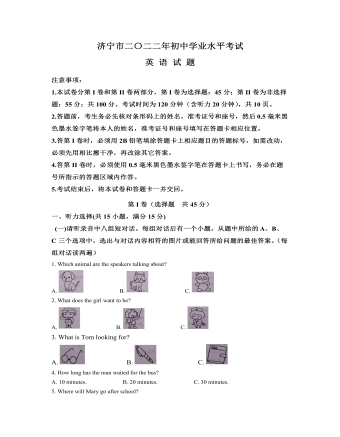
2022年山东省济宁市中考英语真题(原卷版)
Each ofthem has their own experience- two people with synesthesia may both “feel”music, but they almost never feel the music in the same way. For example, onemay feel the music of the violin lightly brushing his face; the other may feelit on her ankle (脚踝). And one’s experience of synesthesia is alwaysthe same. If they see the number 5 in the color blue, then 5 is blue every timethey see it.
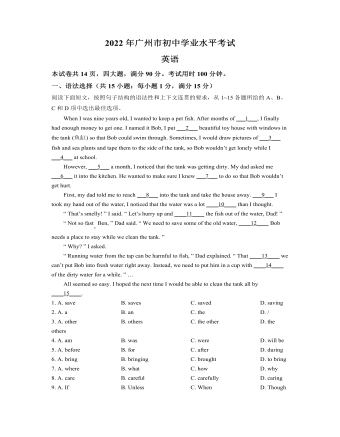
2022年广东省广州市中考英语真题(原卷版)
Slowlybut surely, Amy and her grandparents were making progress. Boxes of all sizeswere placed on top of each other throughout the house. Amy’s grandparents hadlived in the house for years and they had collected many things.
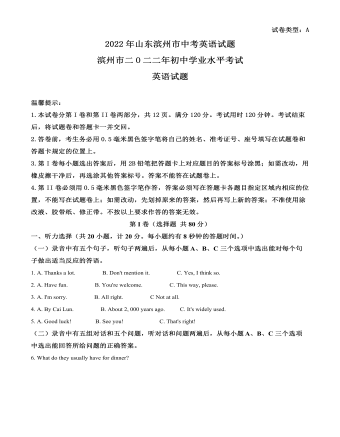
2022年山东省滨州市中考英语真题(原卷版)
As thegovernment encourages the renaissance (复兴) of traditional culture,Hanfu is getting more and more popular with the teenagers. Every year, we canenjoy different Hanfu shows around the cities. And now quite a few Hanfu clubshave been set up in universities. Members usually wear Hanfu at theirgraduation ceremonies or during holidays. Some even wear Hanfu on regular days,too. And these fans created a special day—China Haniu Day to celebratetraditional Chinese clothing. It falls on the third day of the third month inChinese lunar calendar (阴历).
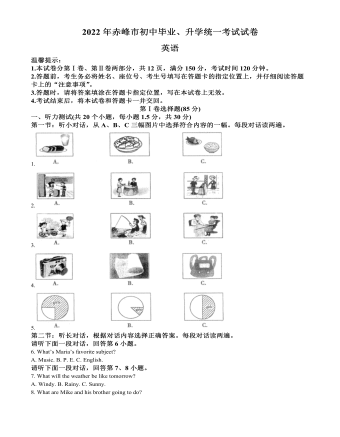
2022年内蒙古赤峰市中考英语真题(原卷版)
We allknow that rice, wheat and corn are staples, but do you know there is anotherkind of staple food—potatoes? Potatoes have many advantages. Theyare a good source of vitamin C and potassium(钾). A potato’s vitamin C isas rich as 10 apples. What’s more,potatoes are low in calories(卡路里)-onlythree fourths of the same amount of wheat and corn, according to People’s Daily. Potatoes are easy togrow. It can be grown in both the north and the south during winter, spring andautumn. The plant is also able to bear drought(干旱). Some areas of China arefacing water shortages, so the potato is safe to grow.
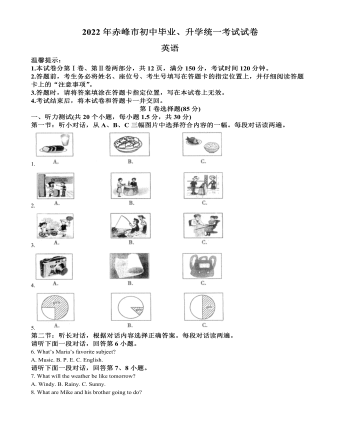
2022年内蒙古赤峰市中考英语真题(解析版)
Chopsticksoriginated from(起源于) China.Though simple and little, they are agreat invention in the history of humans. There are many legends aboutChopsticks, Da Yu and Chopsticks is one of them.It issaid that during Yao and Shun times, Shun ordered Yu to control the flood. Oneday, Yu took a boat to an island, he was so hungry that he used an earth pot tocook meat. After the meat was well-done in boiled water, he didn’t want towaste time to wait for it to cool, so he took two branches to pick up the meatfrom the soup. After, to save time, he always took small branches to take outfood from the hot pot. For a long time, he was skilled at picking up food withsmall sticks. In this way, the first types of chopsticks were born.
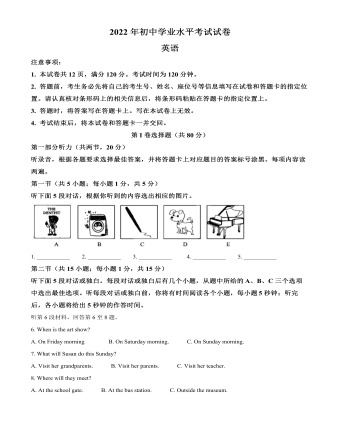
2022年内蒙古包头市中考英语真题(解析版)
Mostschools offer different kinds of subjects and activities for students, but someschools offer additional training in certain areas, such as the performing andarts. In this way, schools can help students develop their artistic talentsfrom an early age and have greater success in their future profession. THE ROYAL BALLET(芭蕾舞)SCHOOL
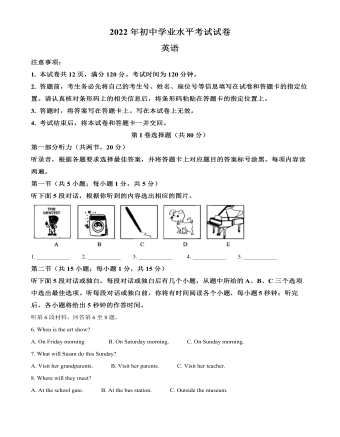
2022年内蒙古包头市中考英语真题(原卷版)
Locatedin the mountains about 100 miles from Los Angeles, the Idyllwild Arts Academyis a boarding school for young artists. It offers training in arts, likedrawing, painting, photography and cinema, along with programmes for theperforming arts. The school’s quiet, rural location also makes it a verypeaceful and beautiful place to learn. THE NATIONAL CIRCUS(杂技)SCHOOL
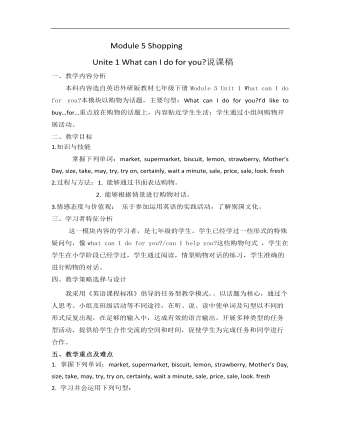
初中英语外研版七年级下册《Module 5 Shopping》说课稿
二、教学目标1.知识与技能掌握下列单词:market, supermarket,biscuit, lemon, strawberry, Mother’s Day, size, take, may, try, try on,certainly, wait a minute, sale, price, sale, look. fresh2.过程与方法:1. 能够通过书面表达购物。2. 能够根据情景进行购物对话。3.情感态度与价值观:乐于参加运用英语的实践活动,了解别国文化。
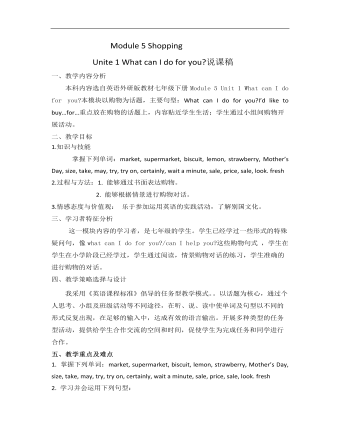
初中英语外研版七年级下册《Module 5 Shopping》说课稿
二、教学目标1.知识与技能掌握下列单词:market, supermarket,biscuit, lemon, strawberry, Mother’s Day, size, take, may, try, try on,certainly, wait a minute, sale, price, sale, look. fresh2.过程与方法:1. 能够通过书面表达购物。2. 能够根据情景进行购物对话。3.情感态度与价值观:乐于参加运用英语的实践活动,了解别国文化。三、学习者特征分析这一模块内容的学习者,是七年级的学生。学生已经学过一些形式的特殊疑问句,像what can I do for you?/can I help you?这些购物句式 ,学生在学生在小学阶段已经学过,学生通过阅读,情景购物对话的练习,学生准确的进行购物的对话。
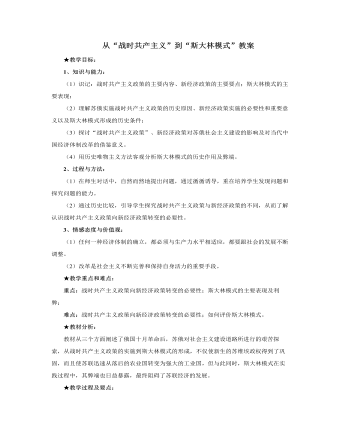
人教版高中历史必修2从“战时共产主义”到“斯大林模式”教案
5、弊端:(1)经济发展不均衡,片面发展重工业,使轻工业和农业长期处于落后状态;(2)对农民的剥夺太重,挫伤了农民的生产积极性;(3)长期执行指令性计划严重削弱了企业的生产自主权,不利于发挥企业的生产积极性,制约了苏联经济的可持续发展。(4)计划经济体制确立后,没有随着社会的变化进行调整,二战后逐渐僵化,丧失了自我完善的功能,成为苏联解体的重要因素。【合作探究】斯大林模式的评价及经验教训:积极:①使苏联迅速实现了 工业化②苏联经济实力的迅速增长,为反法西斯战争的胜利奠定了 物质基础 。消极:①政治:高度集权,破坏了 民主与法制 ; ②经济:优先发展重工业使 农业和轻工业长期处于落后状态,农民生产积极性不高;计划指令,压制了地方和企业的积极性,阻碍苏联经济的发展高度集中的计划经济体制,成为东欧剧变和苏联解体的重要原因。
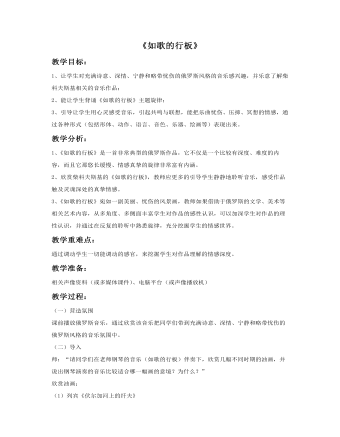
《如歌的行板》教案
教学目标:1、让学生对充满诗意、深情、宁静和略带忧伤的俄罗斯风格的音乐感兴趣,并乐意了解柴科夫斯基相关的音乐作品;2、能让学生背诵《如歌的行板》主题旋律;3、引导让学生用心灵感受音乐,引起共鸣与联想,能把乐曲忧伤、压抑、冥想的情感,通过各种形式(包括形体、动作、语言、音色、乐器、绘画等)表现出来。教学分析:1、《如歌的行板》是一首非常典型的俄罗斯作品,它不仅是一个比较有深度、难度的内容,而且它那悠长缓慢、情感真挚的旋律非常富有内涵。2、欣赏柴科夫斯基的《如歌的行板》,教师应更多的引导学生静静地聆听音乐,感受作品触及灵魂深处的真挚情感。3、《如歌的行板》宛如一副美丽、忧伤的风景画,教师如果借助于俄罗斯的文学、美术等相关艺术内容,从多角度、多侧面丰富学生对作品的感性认识,可以加深学生对作品的理性认识,并通过在反复的聆听中熟悉旋律,充分挖掘学生的情感世界。

《如歌的行板》教案
教学过程:(一)导入(播放大家熟悉的俄罗斯音乐,创设意境)问题一:同学们,我们刚才欣赏的是什么风格的音乐?(……)问题二:那同学们还有哪些会唱的俄罗斯歌曲呢?(请同学们哼唱)问题三:大家感觉俄罗斯音乐有什么特点呢?(充满诗意、深情、宁静、忧伤……)1、介绍作曲家:(播放视频资料,柴科夫斯基以及他的作品剧照)柴科夫斯基,俄国作曲家,生于贵族家庭。他是一个善良、忧郁的音乐诗人,被奉为世界级音乐旋律大师,也是浪漫乐派代表之一。他动人的音乐深深地打动了全世界人民,提到俄国音乐家,往往第一个就会想到他,可以说他是俄国民族音乐继承者与西方音乐的汲取发扬者。2、他创作的作品中,有大家所熟悉的舞剧《天鹅湖》、《睡美人》、《胡桃夹子》和交响诗《罗密欧与朱丽叶》、《悲怆》等。他的音乐充满内心情感和戏剧力量,不仅深为专业音乐工作者喜爱,而且也为广大群众所赞赏。3、要求同学们重点记住他的三部舞剧:《天鹅湖》、《睡美人》、《胡桃夹子》。
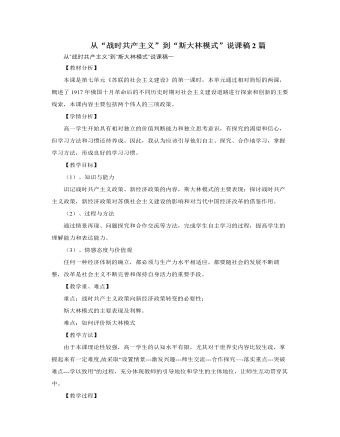
人教版高中历史必修2从“战时共产主义”到“斯大林模式”说课稿2篇
【课堂小结】本课主要讲述俄国十月革命后进行经济建设,并在建设中进行社会主义探索,期间先后出现了战时共产主义政策、新经济政策和斯大林模式,这些政策和体制的产生都是历史和当时现实有关,但也反映出在建设社会主义中既有成功的也由重大失误,主要在于缺乏现成的政策和模式可供借鉴,更在于理论上的缺乏。斯大林模式的形成同苏联当时社会生产力的发展水平相适应,它在初期和战争时期曾发挥了巨大作用,使苏联成为强大的社会主义国家。它建立的高度集中的计划经济体制和新型的工业化模式是苏联进行社会主义建设中的探索和创新,对二战后社会主义国家产生了深刻影响,促进这些国家国民经济的恢复和发展,形成了足以同资本主义相抗衡的社会主义阵营。但是,它没有解决社会主义民主政治建设和经济运行的一系列根本问题,违背了列宁关于把文化经济建设当作工作重心的指示,仍把政治斗争放在第一位。
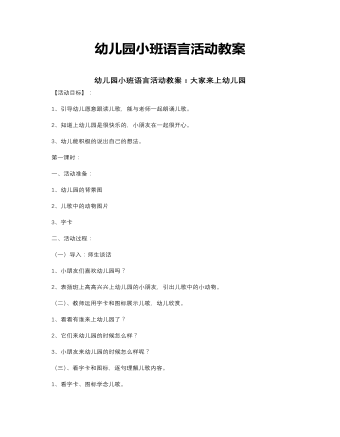
幼儿园语言课活动教案
第一课时: 一、活动准备: 1、幼儿园的背景图 2、儿歌中的动物图片 3、字卡 二、活动过程: (一)导入:师生谈话 1、小朋友们喜欢幼儿园吗? 2、表扬班上高高兴兴上幼儿园的小朋友,引出儿歌中的小动物。
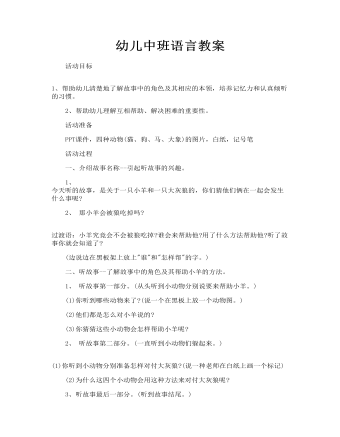
幼儿中班语言教案
一、介绍故事名称--引起听故事的兴趣。 1、 今天听的故事,是关于一只小羊和一只大灰狼的,你们猜他们俩在一起会发生什么事呢? 2、 那小羊会被狼吃掉吗? 过渡语:小羊究竟会不会被狼吃掉?谁会来帮助他?用了什么方法帮助他?听了故事你就会知道了? (边说边在黑板架上放上"谁"和"怎样帮"的字。)
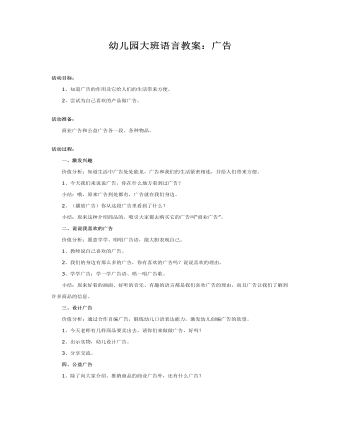
幼儿园大班语言教案:广告
2、尝试为自己喜欢的产品做广告。活动准备: 商业广告和公益广告各一段、各种物品。活动过程: 一、激发兴趣 价值分析:知道生活中广告处处能见,广告和我们的生活紧密相连,并给人们带来方便。1、今天我们来说说广告,你在什么地方看到过广告? 小结:哦,原来广告到处都有,广告就在我们身边。2、(播放广告)你从这段广告里看到了什么? 小结:原来这种介绍商品的,吸引大家都去购买它的广告叫“商业广告”。
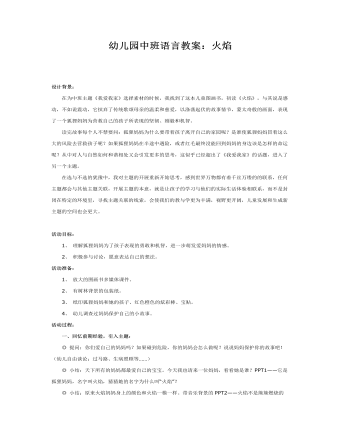
幼儿园大班语言教案:火焰
读完故事每个人不禁要问:狐狸妈妈为什么要带着孩子离开自己的家园呢?是谁使狐狸妈妈冒着这么大的风险去营救孩子呢?如果狐狸妈妈在半途中遇险,或者红毛最终没能回到妈妈的身边该是怎样的命运呢?从中对人与自然如何和谐相处又会引发更多的思考,这似乎已经超出了《我爱我家》的话题,进入了另一个主题。 在选与不选的犹豫中,我对主题的开展重新开始思考,感到世界万物都有着千丝万缕的的联系,任何主题都会与其他主题关联,开展主题的本意,就是让孩子的学习与他们的实际生活体验相联系,而不是封闭在特定的环境里,寻找主题关联的线索,会使我们的教与学更为丰满,视野更开阔,儿童发展和生成新主题的空间也会更大。 活动目标:1、理解狐狸妈妈为了孩子表现的勇敢和机智,进一步萌发爱妈妈的情感。2、积极参与讨论,愿意表达自己的想法。活动准备:1、放大的图画书多媒体课件。2、有树林背景的包装纸。3、纸印狐狸妈妈和她的孩子、红色橙色的炫彩棒、宝贴。4、幼儿调查过妈妈保护自己的小故事。
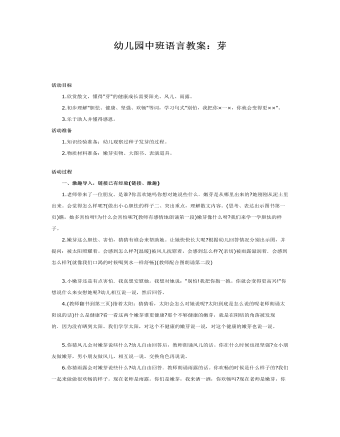
幼儿园中班语言教案:芽
2.初步理解"胆怯、健康、坚强、欢畅"等词,学习句式"别怕,我把你×一×,你就会变得更××"。3.乐于助人并懂得感恩。活动准备1.知识经验准备:幼儿观察过种子发芽的过程。2.物质材料准备:嫩芽实物、大图书、表演道具。活动过程 一、激趣导入,链接已有经验(链接、激趣)1.老师带来了一位朋友。是谁?你喜欢她吗你想对她说些什么.嫩芽是从哪里出来的?她刚刚从泥土里出来。会觉得怎么样呢?(做出小心胆怯的样子二、突出重点,理解散文内容。(思考、表达出示图书第一页)瞧,她多害怕呀!为什么会害怕呢?(教师有感情地朗诵第一段)嫩芽像什么呀?我们来学一学胆怯的样子。2.嫩芽这么胆怯、害怕,猜猜有谁会来帮助她。让她快快长大呢?根据幼儿回答情况分别出示图,并提问:被太阳照耀着。会感到怎么样?(温暖)被风儿抚慰着,会感到怎么样?(亲切)被雨露滋润着.会感到怎么样?(就像我们口渴的时候喝到水一样舒畅)(教师配合图朗诵第二段)